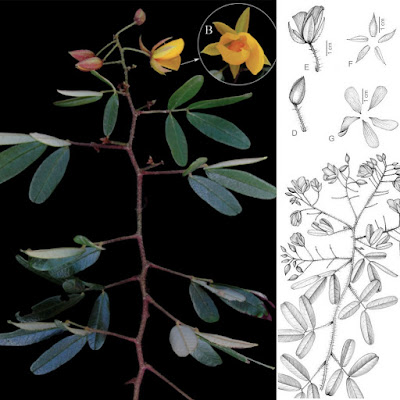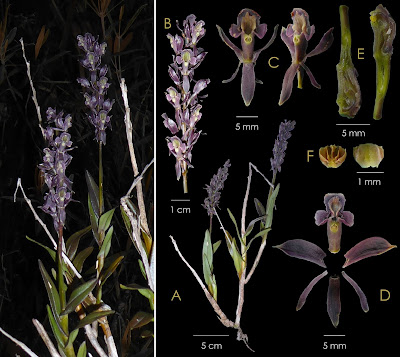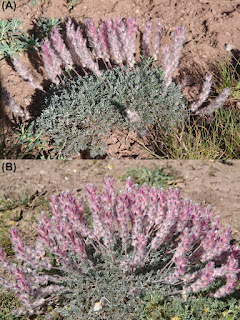[Most Recent Entries] [Calendar View]
Thursday, May 23rd, 2024
| Time | Event | ||||
| 2:56a | [Botany • 2022] Chamaecrista forzzae (Leguminosae) • Morphological Studies of Chamaecrista sect. Absus ser. Setosae With Emphasis on the Chamaecrista setosa Complex, including A New Species
Abstract Chamaecrista is one of the largest genera of Leguminosae, subfamily Caesalpinioideae. Traditionally, it has been divided into six sections, of which Chamaecrista sect. Absus is the largest, with 31 series. Chamaecrista sect. Absus ser. Setosae comprises nine species. Chamaecrista setosa is the most widely distributed species, comprising four varieties, distinguished by the type and distribution of glandular trichomes, and the leaflet venation. Given the importance of leaflet venation in the delimitation of the taxa, here we performed a study of leaflet architecture of all species of the series and a more detailed morphological study for the Chamaecrista setosa complex. For the study of leaf architecture, 2D images of the leaflets were made using the Faxitron x-ray technique. The morphological studies were based on herbarium specimens. We present the details of the leaflet architecture for the species of Chamaecrista sect. Absus ser. Setosae, and we propose nomenclatural changes for a variety of Chamaecrista setosa and some corrections to typifications. During our studies we also found a new species, Chamaecrista forzzae, which is morphologically similar to Chamaecrista setosa and Chamaecrista multiseta. It is here described and illustrated. Keywords: Fabaceae; leaflet architecture; taxonomy; variety Tatiane Santana Silva, Matheus Martins Teixeira Cota, Leonardo Maurici Borges Alexandre Gibau de Lima, Mario Tomazello-Filho and Juliana Gastaldello Rando. 2022. Morphological Studies of Chamaecrista sect. Absus ser. Setosae (Leguminosae) With Emphasis on the Chamaecrista setosa Complex, Including A New Species. Systematic Botany. 47(4); 978-991. DOI: 10.1600/036364422X16674053033796 instagram.com/p/CoFJaRMubN_ Researchgate.net/publication/366506827_M instagram.com/p/CoFJaRMubN_ @petala_botanicalart | ||||
| 6:44a | [Botany • 2022] Centaurea lovricii (Asteraceae: Cardueae) • A New Species of Centaurea sect. Centaurea from Croatia
Abstract A new species, Centaurea lovricii, is described and illustrated from the island of Vis (Dalmatia, Croatia). It occurs on northwest-facing calcareous cliffs near the sea, where it grows with several other rare endemic species. Centaurea lovricii is morphologically similar to C. glaberrima and C. divergens of C. sect. Centaurea, from which it differs in having more succulent leaves with larger and less incised leaflets, bigger capitula, larger phyllaries with more developed appendages and denser and undulate fimbriae, larger florets, bigger achenes, and longer pappus. Its morphological features, distribution, ecology, conservation status and taxonomic affinities are examined. In addition, a new iconography and lectotypification for C. glaberrima and C. divergens is provided. Keywords: Adriatic region, Balkan flora, Centaurea, Croatia, morphology, new species, taxonomy Centaurea lovricii Bogdanović, Boršić, Ljubičić, Brullo & Giusso, sp. nov. Etymology: This species is dedicated to the Croatian botanist Andrija–Željko Lovrić (1943–2018), who was the first to collect it and consider it as a new species. Sandro Bogdanović, Igor Boršić, Ivica Ljubičić, Salvatore Brullo and Gianpietro Giusso del Galdo. 2022. Centaurea lovricii, A New Species of C. sect. Centaurea (Asteraceae) from Croatia. PhytoKeys. 214: 97-114. DOI: 10.3897/phytokeys.214.89404 | ||||
| 7:32a | [Entomology • 2022] Dichetophora koreana & D. nigricorpa • First Record of the Snail-killing Fly Genus Dichetophora Rondani (Diptera: Sciomyzidae) in Korea, with Descriptions of Two New Species
Abstract This paper provides the first report of the snail-killing fly genus Dichetophora Rondani, 1868 on the Korean peninsula with the discovery of two new species, D. koreana sp. nov. and D. nigricorpa sp. nov. Descriptions and illustrations of the new species and keys to the Palearctic species of this genus are given. Keywords: Diptera, Dichetophora koreana, Dichetophora nigricorpa, new species, Korea Yeongjin Son and Sang Jae Suh. 2022. First Record of the Snail-killing Fly Genus Dichetophora Rondani (Diptera: Sciomyzidae) in Korea, with Descriptions of Two New Species. Zootaxa. 5068.1; 125-132. DOI: 10.11646/zootaxa.5068.1.6 | ||||
| 7:47a | [Entomology • 2019] Prymnotomis cecidicola • A New Cecidogenous Species of Many-plumed Moth (Lepidoptera: Alucitidae) associated with Cordiera (Rubiaceae) in the Brazilian Cerrado
Abstract Larvae of many-plumed moths (Alucitidae), especially in the world-wide genus Alucita Linnaeus, 1758 are known as borers or gall-inducers on flowers, fruits and shoots of a few dicotyledonous families, including Bignoniaceae, Caprifoliaceae and Rubiaceae. However, there is no study available on the biology of the monotypic, Neotropical genus Prymnotomis Meyrick, 1931 except for its original description that was based on a single male, the holotype of Prymnotomis crypsicroca Meyrick, 1931 from Espirito Santo, Brazil. We describe here a second species for this genus, Prymnotomis cecidicola sp. nov. whose larvae induce galls on Cordiera elliptica (Cham.) Kuntze (Rubiaceae), a dioecious plant with dimorphic inflorescences found in the Brazilian Cerrado, Planaltina City, Federal District. Adults, larvae, pupae and galls are illustrated under light and scanning electron microscopy. Galls are green, spherical, unilocular and develop individually on C. elliptica flower buds. During development they look like fruits in shape and colour but are larger, do not have style scars when on female plants, and are induced also in male inflorescences. Pupation occurs outside the gall within a silk cocoon, presumably in the litter. A preliminary analysis of DNA barcode sequences including putative members of other alucitid lineages and Neotropical BINs (Barcode Index Number) supports Prymnotomis cecidicola sp. nov. as an independent phylogenetic unit, with 12 to 18% divergence. Its nearest-neighbour was the BIN cluster 5 (BOLD:AAA0842) that includes specimens from Costa Rica. Key words: Alucitid moths, Brazilian Savanna, insect galls, Prymnotomis, taxonomy Prymnotomis cecidicola Moreira & Becker, sp. nov. Diagnosis: Prymnotomis cecidicola shares with the closely related Hexeretmis Meyrick the porrect maxillary palpi, forewing cleft only to 1/5 from termen, and pattern of wing venation. However, it differs from this genus in general appearance in coloration pattern and by presenting deeper hindwing clefts (ca 1/3 of wing length), as pointed out by Meyrick (1931). P. cecidicola can be separated from the congeneric P. crypsicroca Meyrick by the smaller size of the latter, whose forewing length of the type specimen measures ca 6 mm, and by the less contrasting coloration of P. crypsicroca, especially in relation to the hindwing. The basal process of the valva of the male genitalia is upturned, finger-like, covered with sparse filiform setae in P. crypsicroca, while in P. cecidicola it is turned down, looking like a claw, bearing short, stout spines on the base. Etymology: The species name is derived from the Greek kekis – idos = gall + the Latin co – col = with; to be treated as feminine. Gilson R.P. Moreira, Cristiano M. Pereira, Vitor O. Becker, Alexandre Specht and Gislene L. Gonçalves. 2019. A New Cecidogenous Species of Many-plumed Moth (Alucitidae) Associated with Cordiera A. Rich. ex DC. (Rubiaceae) in the Brazilian Cerrado. Zoologia. 36: 1-15. DOI: 10.3897/zoologia.36.e34604 | ||||
| 9:07a | [Botany • 2024] Sedum xunvense (Crassulaceae) • A New Species from Southeast China
Abstract In this paper, Sedum xunvense is described as a new species from Zhejiang, Southeast China. Sedum xunvense is morphologically similar to S. formosanum, but the latter differs in clustered and robust stems (vs. solitary, slender), green or slightly red smooth stems and inflorescence rachises (vs. purple-red and ribbed), thick and succulent leaves (vs. thin), yellow anthers (vs. reddish-brown), erect follicles (vs. oblique), and is found in dry habitats in rock crevices (vs. damp ravines, rocks and mossy thickets). A reconstructed ML phylogeny of Sedum, based on nrITS sequence data, strongly suggests that S. xunvense forms an independent clade that is sister to a larger clade of many species, including S. formosanum. Crassulaceae, plastome, Sedum formosanum, Southeast China, Zhejiang, Eudicots
Sedum xunvense Y.L. Xu & P. Li, sp. nov. Mao-Lin CHAI, Ya-Meng WU, Yang ZHANG, Jin-Bao PU, Bin CHEN, Yue-Liang XU and Pan LI. 2024. Sedum xunvense, A New Species from Southeast China. Phytotaxa. 644(4); 258-270. DOI: 10.11646/phytotaxa.644.4.2 | ||||
| 2:34p | [Botany • 2024] Kaempferia sakolchaii (Zingiberaceae) • New Taxa from Northeastern Thailand
Abstract An examination of the diversity of Zingiberaceae in Thailand led to the discovery of two undescribed taxa within the genus Kaempferia: K. sakolchaii P. Saensouk, Saensouk & Boonma, a newly described species, and K. phuphanensis var. viridans P. Saensouk, Saensouk & Boonma, a novel variety. Additionally, our investigation encompassed the chromosome numbers, karyotypes, and pollen morphological characteristics of these taxa. Both taxa share a chromosome number of 2n = 22, accompanied by distinctive karyotype patterns. Kaempferia sakolchaii displays a karyotype of 12m + 10sm chromosomes, while K. phuphanensis var. viridans presents a karyotype of 10m + 10sm + 2st chromosomes. The pollen grains of K. sakolchaii and K. phuphanensis var. viridans are monads, spheroidal in shape, radially symmetrical, apolar, inaperturate, and exine sculpturing irregularly arranged elongated ornamentation elements with verrucate features. This comprehensive analysis provides valuable insights into the taxonomic classification of these two taxa, enriching our understanding of Zingiberaceae diversity in Thailand. Keywords: Kaempferia; new species; new variety; Sakon Nakhon; taxonomy; Thailand; Zingiberceae Kaempferia sakolchaii P. Saensouk, Saensouk & Boonma sp. nov. Subgenus Kaempferia Kaempferia sakolchaii is similar to K. siamensis, but differs in that it has lamina that are narrowly ovate to broadly ovate, adaxially dark green alternated with silver or white longitudinal stripes, with small black dots along the margin, and abaxially pale green with small black dots (vs. K. siamensis having lamina sub-orbicular to orbicular, adaxially plain green, with small black dots only at the distal part, abaxially pale green without small black dots); anther crest c. 6 × 3 mm, bilobed, each lobe apex with four sub-lobes (vs. anther crest c. 5 × 2.5 mm, bilobed, each lobe apex acute); ovary c. 3 × 2 mm (vs. c. 4 × 2); and epigynous glands c. 3 mm long (vs. 6 mm long). Etymology: The specific epithet “sakolchaii” was bestowed in honor of Professor Emeritus Dr. Sumon Sakolchai, who has a high level of knowledge and skill in the field of pharmacy. Furthermore, he has made significant contributions to the field of pharmaceutical botany, both in Thailand and across the world. In addition, he makes essential contributions as a behind-the-scenes person, providing consistent assistance to researchers in botany and pharmaceutical sciences. Previously, he was the President of Khon Kaen University in Thailand, the President of the Pharmacy Council of Thailand, and currently acts as the President of Burapha University Council in Thailand. “เปราะอาจารย์สุมนต์” Piyaporn Saensouk, Surapon Saensouk, Thawatphong Boonma, Sarayut Rakarcha , Pathomthat Srisuk and Vincent O. Imieje. 2024. Kaempferia sakolchaii sp. nov. and K. phuphanensis var. viridans var. nov. (Zingiberaceae), Two New Taxa from Northeastern Thailand. Horticulturae. 10(5), 430. DOI: 10.3390/horticulturae10050430 facebook.com/WalaiRukhavej/posts/904906 | ||||
| 2:45p | [Entomology • 2024] Baetiella baei, B. lannaensis & B. bibranchia • Taxonomic Notes on the Genus Baetiella Uéno, 1931 (Ephemeroptera: Baetidae), with Description of Three New Species from Thailand Abstract Based on material recently collected in northern Thailand, the present study provides an updated of the genus Baetiella, including Gratia. It comprises six species in Thailand, three of them being new species: Baetiella (Gratia) narumonae, Baetiella (Gratia) sororculaenadinae, Baetiella (Baetiella) bispinosa, Baetiella (Baetiella) baei sp. nov., Baetiella (Baetiella) lannaensis sp. nov. and Baetiella (Baetiella) bibranchia sp. nov. Baetiella (Baetiella) baei sp. nov. can be distinguished from other species by the reduction of the posteromedian protuberances on abdominal tergites I–III, the asymmetrical coniform terminal segment of labial palp, the distal margin of abdominal sternites VII–X each with a row of long, spatulate setae, the dorsal margin of femur with two long, robust setae distally. Baetiella (Baetiella) lannaensis sp. nov. is diagnosed by the posteromedian protuberances present on tergites I–VIII, dorsal margin of femur with a regular row of long, rounded, ciliated setae and body surface covered with numerous, dense, rounded scale-like setae. Baetiella (Baetiella) bibranchia sp. nov. can be separated from other species by coxal gills present at the base of forelegs and midlegs. The molecular study based on the mitochondrial gene COI and a larval key to species of Thai Baetiella are also provided. Key words: COI gene, diversity, mayflies, revision, Southeast Asia
Sirikamon Phlai-ngam, Boonsatien Boonsoong, Jean-Luc Gattolliat and Nisarat Tungpairojwong. 2024. Taxonomic Notes on the Genus Baetiella Uéno, 1931 (Ephemeroptera, Baetidae), with Description of Three New Species from Thailand. ZooKeys. 1200: 303-352. DOI: 10.3897/zookeys.1200.116787 | ||||
| 2:54p | [Botany • 2022] Epidendrum chrisii-sharoniae (Orchidaceae: Laeliinae) • A New Species in the Yanachaga Chemillen National Park, Pasco, Peru
Epidendrum chrisii-sharoniae belongs to the ‘Pergracile Group’ and the ‘Rhodoides Subgroup’ (Hágsater: 2004: pl. 730), which is characterized by the caespitose habit, the racemose inflorescence with narrow, parallel-sided spathes, the flowers with a wide, rounded mid-lobe and a large fleshy disc. The new species is recognized by the 4–8, oblong-lanceolate leaves, 2–3 spathes covering the whole length of the peduncle of the inflorescence, the flowers that are simultaneous, ... Keywords: Herbarium of Selva Central, HOXA, high montane sclerophyllous forest, Reserve of Biosphere Oxapampa-Ashaninka-Yanesha, Pergracile Group, Monocots Epidendrum chrisii-sharoniae L.Valenz. & E.Santiago, sp. nov. Etymology:—Honoring botanists Christopher and Sharon Davidson, who have supported botanical research and fieldwork by Missouri Botanical Garden in Peru. Luis Valenzuela Gamarra and Elizabeth Santiago Ayala. 2022. A New Species of Epidendrum (Laeliinae: Orchidaceae), in the Yanachaga Chemillen National Park, Pasco—Peru. Phytotaxa. 543(2); 163-169. DOI: 10.11646/phytotaxa.543.2.7 [2022-04-12] facebook.com/gesneria68/posts/102206133 twitter.com/monteagudomendo/status/15312 | ||||
| 3:01p | [Botany • 2024] Astragalus nordizensis (Fabaceae) • A New Species of Astragalus Sect. Hymenostegis from Van Province, Türkiye
Abstract Astragalus nordizensis Fırat (sect. Hymenostegis Bunge), is described as a new species from Gürpınar district of Van province, Türkiye. From the morphological point of view, the new species appears to be most similar to Astragalus zohrabi Bunge and A. rubrostriatus Bunge, but it differs in several morphological characters including peduncle indumentum, inflorescence shape, leaf and flower, fruit and seed morphology, etc. A comprehensive description of this new species is provided, including detailed photographs, geographical distribution map, habitat and ecology, vernacular name and IUCN conservation status. Keywords: Astragalus, endemic, new species, Türkiye, Van, Warbilind Mehmet Fırat. 2024. Astragalus nordizensis (Fabacaea), A New Species from Van province (Türkiye) belonging to section Hymenostegis. Nordic Journal of Botany. DOI: 10.1111/njb.04172 |
| << Previous Day |
2024/05/23 [Calendar] |
Next Day >> |




































